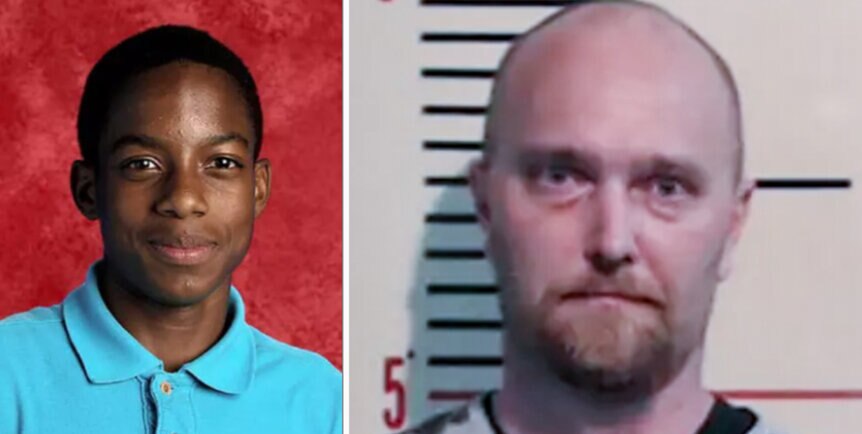Create a free profile to get unlimited access to exclusive videos, breaking news, sweepstakes, and more!
Disgraced Texas Cop Roy Oliver Convicted Of Murdering Unarmed 15-Year-Old Jordan Edwards
Roy Oliver claimed he opened fire on a car of unarmed teens to save his partner, but body cam video of the incident proved otherwise.
A white former Texas police officer was found guilty of murder Tuesday for firing his assault rifle into a car full of unarmed, black teenagers, killing one of them.
Roy Oliver, 38, was convicted after a jury trial of killing 15-year-old Jordan Edwards, a high school freshman, in the Dallas suburb of Balch Springs on April 29, 2017, the Dallas Morning News reports.
The jury deliberated more than 12 hours on Monday and Tuesday before delivering a guilty verdict -- a rare occurrence for a police officer accused of wrongfully taking life without just cause.
Edwards’ family and friends hugged one another inside the courtroom when the guilty verdict was read. Some cried. In the hallway outside the courtroom someone yelled, “Oh praise God!,” the Dallas Morning News reports.
The judge presiding over the case, Brandon Birmingham, immediately revoked Oliver’s bond and remanded him to the Dallas County jail. He faces life in prison. His wife, Ingrid, broke down in tears as she left the courtroom, without him. They have a 3-year-old son with autism.
Edwards’ father, Odell, told reporters “I just want to say I’m happy, very happy. It’s been a long time, hard year. Just really happy.”
His lawyer, Daryl Washington, said the verdict would sound like a bell through black communities across America. “It’s about every, every African-American, unarmed African-American, who has been killed and who has not gotten justice.”
At the time, Edwards’ killing could be seen as just the latest in a long line of fatal police shootings of black men, largely by white police officers, that became rallying points for critics of police brutality -- cases including the deaths of Michael Brown, Eric Garner, Tamir Rice, Walter Scott, Alton Sterling and scores of other names usually known only to those who live in the same cities where they were killed.
Oliver murdered Edwards when, along with his partner Tyler Gross, he responded to a call of intoxicated teenagers, and found a house party in full swing. As Oliver and Gross were clearing party-goers from the house --- “It’s like a sardine can. They just keep coming out,” Oliver joked --- shots were fired outside.
Video footage from Oliver’s body camera shows what happened next.
Oliver ran to his car, grabbed his department-issued assault rifle and loaded it, while Gross ran up the street and tried to stop a car. Oliver caught up with Gross, just after Gross smashed the car’s rear passenger window as the car was maneuvering to pull away.
When the car started moving, Oliver fired five times. Inside the car, Edwards was sitting in the front passenger seat, riding with his two brothers and two friends. At first, his companions didn’t realize Edwards had been shot -- no one else was hit.
It wasn’t until they drove away that they saw smoke coming from Edwards’s head, Lee Merritt, an attorney for Jordan’s family, told the Washington Post shortly after the shooting. Edwards was pronounced dead at the hospital, killed instantly by a bullet through his brain.
On Thursday, Oliver testified in his own defense, and told that jury he had to shoot.
“I had no other option than to use lethal force. I almost watched my partner get hit by a car,” Oliver said, according to the Washington Post.
But Dallas County first assistant District Attorney Michael Snipes countered in his closing argument that Oliver was an “angry, out-of-control walking bomb. A time bomb. That went off on April the 29th, 2017.”
As proof, Snipes pointed to a Facebook post Oliver authored that said “‘I’ve never been as good at anything in my life as I am at killing people.’ Who says that? He does.”
Oliver served in the U.S. Army as an infantryman and saw two tours of combat duty in Iraq. He had wanted to become a firefighter after high school, he testified, but didn’t score high enough on the civil service test. He enlisted, he said, because it would improve his score.
Other evidence that Snipes pointed to during his summation was Oliver’s body camera footage, which provided an objective record of events for the jury to independently evaluate, without having to make a difficult credibility judgment as to the circumstances that allegedly made Oliver fear for Gross’s safety.
That footage, Snipes said, made clear Oliver had nine full seconds to assess the situation, including any threat the vehicle posed to Gross. The video showed that “at no time was Officer Gross in danger,” Snipes said.
The body camera footage changed everything, from the start, and likely played a key role in the jury’s verdict.
After the shooting, Oliver told supervisors that he fired because he thought Gross was going to get run over, and the Balch Springs Police Department issued a statement saying the car was being driven in an “aggressive manner.”
But a day later, after Balch Springs Police Chief Jonathan Haber viewed the video, he held a news conference and changed the department’s story, acknowledging that the video showed the opposite, that the car was being driven slowly away from the officers, according to the New York Times.
Two days after that, Haber fired Oliver, for unspecified violations of “departmental guidelines.”
The 2014 killing of Michael Brown by Ferguson, Missouri police officer Darren Wilson sparked a wave of public criticism of excessive police violence, especially against unarmed black men, and led to the widespread use of police body cameras.
Oliver’s department, Balch Springs, has used them since at least April 2016, according to a report by Fox 5 Dallas.
Many believed that police use of body cameras would moderate police officers’ impulse to use force, or at least hold those who use excessive force accountable. It seems like that is exactly what happened here -- a white officer who shot an unarmed black teenager with an department-issued assault rifle was convicted of murder.
But, nationally, only 8 percent of prosecutors who use body camera evidence in criminal cases ever used it to prosecute a police officer, while almost all had used it as evidence against citizens, according to a 2016 George Mason University study.
The last Dallas police officer convicted of murder on-duty was Darrell L. Cain, for playing a fatal game of Russian roulette with a .357 magnum and a 12-year-old boy named Santos Rodriguez he had arrested in July 1973, according to court records.
Cain thought Rodriguez stole $8 from a gas station vending machine, and wanted the boy to confess. So he took five bullets out of his six-shot service weapon, spun the revolver’s cylinder, aimed the gun at the boy’s head and pulled the trigger. Rodriguez was in the backseat of Cain’s patrol car, handcuffed.
The gun’s hammer clicked down on an empty chamber. But the boy still wouldn’t give Cain the confession he wanted. Cain pointed his gun at the boy’s head, again, and again pulled the trigger. This time, brain matter and blood soaked the backseat of his patrol car.
Cain was sentenced to five years in prison, but only served two-and-a-half.
[Photos: Dallas County District Attorney’s Office]



























